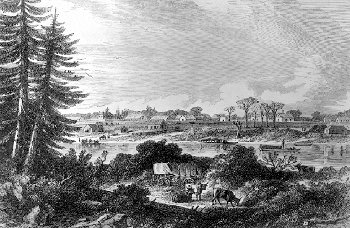Courses
- British Columbia History
- Canadian History
- British North American Colonial History
- Daily life in the Crown Colony of Vancouver Island around 1858
- Important events in the historical development of British Columbia
- Primary and secondary source analysis including visual sources
- Continuity and change in history
Daily Life in Victoria before and after the Fraser Canyon Gold Rush
Step 1: Introduce drawing inferences about daily life
Explain to students that historians use texts (diaries, letters, newspapers) and images (paintings, drawings, photographs, film) as sources of information about the conditions of life in a given place and time. As an opening activity, invite students to make observations and draw inferences about daily life based on a drawing of Fort Victoria in the Colony of Vancouver Island around 1857.
Distribute a copy of the image, #1 Drawing of Colonial Victoria, to each student or simply project the image on a screen for the entire class to see. As a class, invite students to describe things they see in the image.

After students have made a number of observations—describing exactly what they see in the image—invite them to draw possible conclusions about what it was like to live in Fort Victoria at this time. Explain that students are going to practise drawing inferences—conclusions that are not directly seen in the image but are reasonable based on what can be observed. For example, there appears to be livestock in the foreground of the image. This suggests that farming was an economic activity in the area, and perhaps that people had access to milk and cheese as by-products of these domesticated animals.
Distribute copies of the activity sheet, #2 Portrait of Daily Life, to each pair of students. Draw students’ attention to the aspects of daily life recorded across the top of the activity sheet. Explain that this image does not provide information about all of the themes listed. Suggest that students focus on those aspects that most apply to the image. For example, the most relevant themes appear to be shelter/housing, economic activity, transportation, and landscape. Ask students to record up to seven observations, indicate the aspect(s) of daily life that features in each observation, and draw a plausible inference about daily life based on each observation.
Encourage students to look beyond obvious details, and try to extract as much information as possible from the image. One way to do this is to scan the foreground, middle ground and background when locating relevant details.
Invite several students to share their most interesting or informative inferences about daily life and to indicate the observations that support each conclusion. If useful, provide students with a copy of the illustrative observations and inferences that are found in #3 Sample Portrait of Daily Life.





